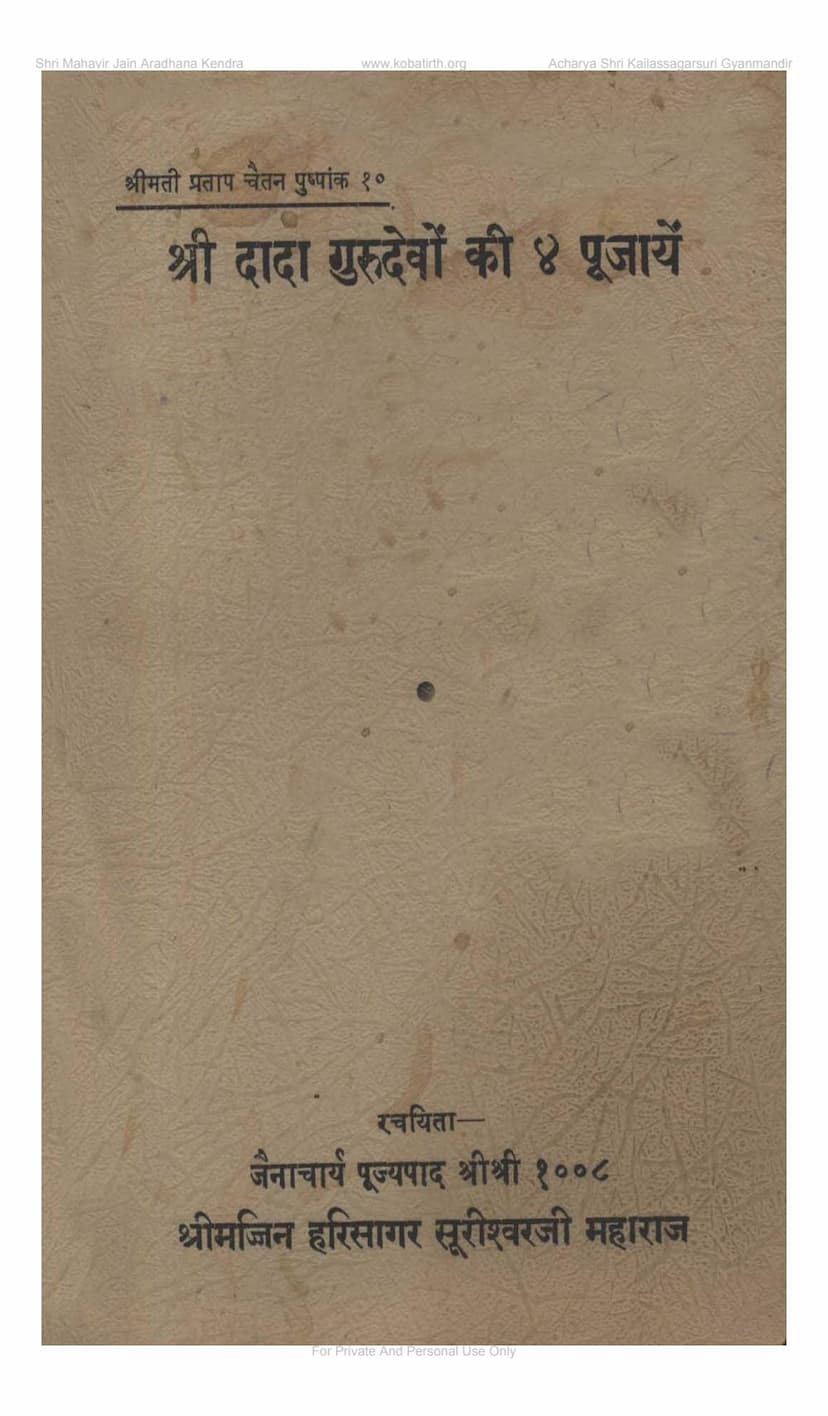Dada Gurudevo Ki Char Pujaye
Added to library: September 1, 2025

Summary
This document is the Jain text "Dada Gurudevo ki Char Pujaye" (Four Pujas of the Dada Gurudevs) authored by Jainacharya Pujyapada Shri Jin Harisagarsuri. The publisher is the Shri Jain Shwetambar Upashray Committee, Calcutta.
The book is dedicated to the memory of late Pra. Shri Pratapsri M. Sa. and her disciple Darshanashri Riddhishri M. Sa., with the support of devotees of Gurudev from Calcutta, under the guidance of Chandrashriji.
Introduction:
The introduction highlights the significance of the "Dada Gurudevs" in Jain Shasan, describing them as brilliant, miraculous, benevolent, and wish-fulfilling beings, akin to Kalpavriksha trees. It states that there have been four prominent gurus known by the name "Shri Dadaji Maharaj." The book contains four pujas (acts of worship) dedicated to each of these four Dada Gurudevs, composed in simple and sweet language by Acharya Shri Jin Harisagarsuri. The intention is for devotees to understand the divine historical lives of the Dada Gurudevs and attain oneness with their virtues.
The Four Dada Gurudevs and their brief biographies:
-
First Dada Gurudev: Shri Jinadatta Surishwarji Maharaj (12th Century Vikram)
- Known for his yogic and ascetic powers, attracting many divine beings and deities as devotees.
- A prominent figure in the Kharatara Gachchha, a successor to Shri Abhaydeva Surishwarji, and a contemporary of the great poet Shri Jin Vallabha Surishwarji.
- Born in Dhavalaka (Gujarat), his heavenly abode is in Ajmer (Rajasthan), famous for his miracles. His death anniversary is celebrated on Ashadh Shukla 19.
-
Second Dada Gurudev: Shri Jinachandra Surishwarji Maharaj (known as Manidhariji Maharaj)
- Successor to the first Dada Gurudev.
- Converted the Mahattiyana caste to Jainism and initiated Delhi's ruler, Madanpal, into Jainism.
- Increased the number of gotras (lineages) in the Shrimal caste. He had a luminous gem on his forehead.
- His birthplace was Vikrampur (in Jaisalmer), and his heavenly abode is famously near Qutub Minar in Delhi.
-
Third Dada Gurudev: Shri Jinkushala Surishwarji Maharaj (14th Century Vikram)
- Successor to Shri Jinachandra Surishwarji, who was known as Kalikalan Kevi (omniscient of the present era) and initiated four kings.
- Initiated many non-Jains into Jainism and was served by several deities.
- Born in Samiana (Siwana, Marwar), his heavenly abode is in Deorawar (Sindh).
- Devotees observe fasts in his name on Mondays and full moon/new moon days. He is considered a "Chintamani" (wish-fulfilling gem) for overcoming worries. His death anniversary is celebrated on Phalguni Amavasya.
-
Fourth Dada Gurudev: Shri Jinchandra Surishwarji Maharaj (17th Century)
- A great propagator of Jainism, successor to Shri Jinamanikya Surishwarji.
- Influenced Mughal Emperor Akbar towards the path of Ahimsa (non-violence). Emperor Akbar issued decrees promoting compassion and protection of life in his empire due to Akbar's devotion to this Guru.
- His asceticism and spiritual power are credited with Akbar's late-life focus on dharma.
- Saved over a thousand metal idols of Tirthankaras from destruction by Mughals during the looting of Sirohi. These idols are preserved in the Chintamani Bhandar in Bikaner and are occasionally worshipped for the removal of obstacles.
- He successfully advocated for the cancellation of Emperor Jahangir's decree prohibiting the movement of ascetics, serving the Jain Sangh greatly.
- He resolved disputes within the Jain community by defeating Dharmasagar Upadhyay with the mediation of acharyas of the 84 Gachchhas.
- He had influential devotees like the brave and charitable minister Karmachandra Bachhawat. The Porwad brothers Shiya and Somji of Ahmedabad prospered due to his grace and rendered great service to Jainism.
- His birthplace was Khetsar (Marwar), and his heavenly abode is in Bilada. His death anniversary is celebrated as "Dada Dooj" on Ashwin Badi 2 (Bhadrapada Badi 2 in Gujarati calendar) in various cities like Palanpur, Patan, Ahmedabad, Surat, Khambhat, Jamnagar, and Bombay, with fairs and jayantis.
The introduction also mentions that detailed historical biographies of these four Dada Gurudevs have been published in Hindi by Shri Agarchand Ji Bhanwaralal Ji Nahata, with Gujarati translations also available.
The book then proceeds to detail the pujas for each Dada Gurudev, starting with Shri Jinadatta Surishwarji Maharaj. The pujas include:
- Guru Pad Sthapana (Invocation and Installation of Guru's Feet): With specific mantras.
- Jal Puja (Water Puja): With verses describing the purity of water and the Guru's purifying qualities.
- Chandan Puja (Sandalwood Puja): Highlighting the cooling and soothing properties of sandalwood and the Guru's ability to alleviate suffering.
- Pushpa Puja (Flower Puja): Emphasizing the fragrance and beauty of flowers as offerings to the Guru.
- Dhoop Puja (Incense Puja): Describing incense as a symbol of spreading good fragrance and removing negative influences.
- Deepak Puja (Lamp Puja): Representing the dispelling of ignorance and the illumination of knowledge.
- Akshat Puja (Unbroken Rice Puja): Symbolizing purity and auspiciousness.
- Naivedya Puja (Food Offering Puja): Representing the offering of pure and delicious food.
- Phala Puja (Fruit Puja): Symbolizing the sweet fruits of devotion and spiritual attainment.
- Vastra Puja (Clothing Puja): Symbolizing purity and modesty.
- Dhwaj Puja (Flag Puja): Symbolizing the victory and propagation of Jainism.
The text then continues with similar pujas dedicated to Manidhari Shri Jinachandra Surishwarji Maharaj, followed by Shri Jinkushala Surishwarji Maharaj, and finally Shri Jinachandra Surishwarji Maharaj (the fourth one, known for influencing Emperor Akbar). Each puja follows the same structure of invocation, installation, and offerings of various items, accompanied by devotional verses and songs set to specific tunes (tarz).
The book concludes with Aarti (a form of devotional worship with lamps) and Mangal Deepak (auspicious lamp) for each Dada Gurudev, followed by a concluding prayer and the author's name. The collection of these four pujas is meant to foster devotion and aid in the propagation of the Jain faith.